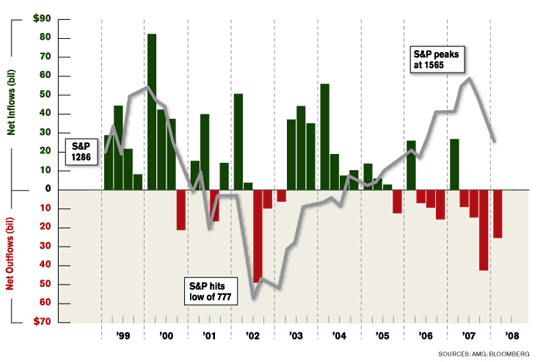I first wrote of this phenomenon last September in a post titled “Disappointing Returns“. In that post I cited data that reported that for the 20 years ended Dec. 31, 2006, the average stock fund investor earned a paltry 4.3 average annual compounded return compared to 11.8 percent for the Standard & Poor’s 500 index. Wow, that’s abysmal. These investors would have fared better by staying in CDs during that time. Last month (the June issue) in Smart Money magazine, I found this telling graph;

What we find is that investors don’t buy and hold. Not by a long shot. They pour money in just at the market is reaching a top, and then, just as the market reaches a short term low, they panic, and sell their funds. Thus the title of my post today.
Joe

Joe, this has been a well known phenomenon for 20 years. How do you suppose investment counselors account for it? Simply telling folks not to doesn’t cut it. And, beyond that when you look at individuals you find that they take funds for emergency uses, like loss of job, sickness, caring for parents, kid expense like private school and marraige. This is the whole fallacy of mutual fund investing. Few folks go 35 years without some periods of time with no inputs. Its called life events. And when you add in the emotions which people invest with, you have the results we have.
Dave – I don’t have the answer. I hope that people reading these posts and the articles and/or data I quote will help them avoid some of these mistakes. People can only protect themselves so well to try to insulate themselves from the life events you cite. Even the best prepared person can’t avoid the consequences of a major tragedy.
Joe